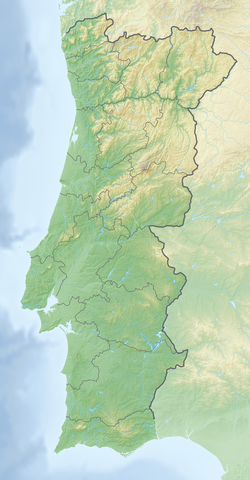Lisbon
Lisbon
Lisboa | |
|---|---|
| Motto(s): Mui Nobre e Sempre Leal "Very Noble and Always Loyal" | |
 Location of Lisbon | |
| Coordinates:38°43′31″N09°09′00″W/ 38.72528°N 9.15000°W | |
| Country | |
| Metro | Lisbon metropolitan area |
| District | Lisbon |
| Historic province | Estremadura |
| Settlement | c. 1200BCE |
| RomanOlissipo | c. 138 BCE |
| Moorish rule | 711CE |
| Siege of Lisbon | 1147 CE |
| Capital city | 1256 CE |
| Civil parishes | (see text) |
| Government | |
| • Type | Local administrative unit |
| • Body | Concelho/Câmara Municipal |
| • Mayor | Carlos Moedas |
| •Municipal chair | Rosário Farmhouse |
| Area | |
| •Capital city | 100.05 km2(38.63 sq mi) |
| • Metro | 3,015.24 km2(1,164.19 sq mi) |
| Elevation | 2 m (7 ft) |
| Population (2023) | |
| •Capital city | 567,131[1] |
| • Density | 5,445.7/km2(14,104/sq mi) |
| •Metro | 2,961,177[2] |
| Demonym(s) | Lisboan Lisboeta Olissiponense Alfacinha(colloquial) |
| Time zone | UTC(WET) |
| • Summer (DST) | UTC+1(WEST) |
| Postal zone | 1149-014 Lisboa |
| Area code | (+351) 21 XXX XXXX |
| Patron saint | Vincent of SaragossaandAnthony of Lisbon |
| Municipal address | Praça do Município, 1 1149-014 Lisboa |
| Municipal holidays | 13 June (St. Anthony's Day) |
| Website | cm-lisboa.pt |
Lisbon(/ˈlɪzbən/;Portuguese:Lisboa[liʒˈβoɐ])[3]is the capital and largest city ofPortugal,with an estimated population of 567,131 as of 2023 within its administrative limits[4]and 2,961,177 within themetropolis.[5]Lisbon is mainlandEurope's westernmost capital city (second overall afterReykjavik) and the only one along the Atlantic coast, the others (Reykjavik andDublin) being on islands. The city lies in the western portion of theIberian Peninsula,on the northern shore of the RiverTagus.The western portion of its metro area, thePortuguese Riviera,hosts the westernmost point ofContinental Europe,culminating atCabo da Roca.
Lisbon is one of theoldest cities in the world[6]and the second-oldest European capital city (afterAthens), predating other modern European capitals by centuries.[7]Settled by pre-Celtic tribes and later founded and civilized by the Phoenicians,Julius Caesarmade it amunicipiumcalledFelicitas Julia,[8]adding the term to the nameOlissipo.After thefall of the Roman Empire,it was ruled by a series ofGermanic tribesfrom the 5th century, most notably theVisigoths.Later it was captured by theMoorsin the 8th century. In 1147Afonso Henriquesconquered the cityand in 1255 it becamePortugal'scapital, replacingCoimbra.[9]It has since been the political, economic, and cultural centre of the country.
As the political centre of the country, Lisbon hosts thegovernment,National Assembly,Supreme Court of Justice,Armed Forcesand residence of thehead of state.It is also the centre of Portuguese diplomacy, with ambassadors from 86 countries residing in the city, as well as representations fromTaiwanandPalestine.[10]About 2.96 million people live in theLisbon metropolitan area,which extends beyond the city's administrative area, making it the third largest metropolitan area in theIberian Peninsula(afterMadridandBarcelona) as well as figuring amongst the10 most populous urban areasin theEuropean Union.[11][12]It represents approximately 27.83% of the country's population.
Lisbon is recognised as anAlpha -level global citybecause of its importance in finance, commerce, fashion, media, entertainment, arts, international trade, education, and tourism.[13][14]Lisbon is amongst the two Portuguese cities (the other beingPorto) to be recognised as a global city, and it is also home to three companies in theGlobal 2000(EDP Group,Galp EnergiaandJerónimo Martins).[15][16][17]Lisbon is one of the major economic centres inEurope,with a growing financial sector, withPSI-20being part ofEuronext,the largest center for debt and funds listings in the world. TheLisbon regionhas ahigher GDP PPP per capitathan any otherregionin Portugal. Its GDP PPP amounts to US$179 billion and thus $61,713 per capita.[18][19][20][21]The city occupies the 40th place of highest gross earnings in the world and, with almost 21,000 millionaires, is the 11th European city by number of millionaires and the 14th by number of billionaires.[22][23]Most of the headquarters ofmultinational corporationsin Portugal are located in the Lisbon area.[24]
Etymology[edit]
Lisbon's name may have been derived fromProto-CelticorCelticOlisippo,Lissoppo,or a similar name which other visiting peoples like the ancient Phoenicians, Greeks and Romans adapted accordingly, such as the pre-Roman appellation for the Tagus River,LissoorLucio.Classical authors writing in Latin and Greek, includingStrabo,Solinus,andMartianus Capella,[25][26]referred to popular legends that the city of Lisbon was founded by the mythical hero Ulysses (Odysseus).[27][28]Lisbon's name was writtenUlyssippoin Latin by the geographerPomponius Mela,a native ofHispania.It was later referred to as "Olisippo" byPliny the Elderand by the Greeks asOlissipo(Ὀλισσιπών) orOlissipona(Ὀλισσιπόνα).[29][30]
Another claim repeated in literature is that the name of Lisbon could be traced back to Phoenician times, referring to a supposed Phoenician termAlis-Ubbo,meaning "safe harbour" or "pleasant haven".[31][32][33]Although modern archaeological excavations show a Phoenician presence at this location since 1200BC,[34]this folk etymology "is never attested in ancient classical literature".[35]
Lisbon's name is commonly abbreviated as "LX" or "Lx", originating in an antiquated spelling of Lisbon asLixbõa.[36]While the old spelling has since been completely dropped from usage and goes against modern language standards, the abbreviation is still commonly used.
History[edit]
Origins[edit]
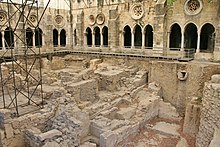
During theNeolithicperiod, the region was inhabited by Pre-Celtic tribes, who built religious and funerary monuments,megaliths,dolmensandmenhirs,which still survive in areas on the periphery of Lisbon.[37]TheIndo-EuropeanCeltsinvaded in the 1st millennium BC, mi xing with thePre-Indo-Europeanpopulation, thus giving rise to Celtic-speaking local tribes such as the Cempsi orSefes.
Although the first fortifications on Lisbon'sCastelohill are known to be no older than the 2nd century BC, recent archaeological finds have shown thatIron Agepeople occupied the site from the 8th to 6th centuries BC.[38][39][40]This indigenous settlement maintained commercial relations with the Phoenicians, which would account for the recent findings of Phoenician pottery and other material objects. Archaeological excavations made near theCastle of São Jorge(Castelo de São Jorge) andLisbon Cathedralindicate a Phoenician presence at this location since 1200 BC,[34]and it can be stated with confidence that a Phoenician trading post stood on a site[41][42]now the centre of the present city, on the southern slope of the Castle hill.[43]The sheltered harbour in theTagus Riverestuarywas an ideal spot for anIberiansettlement and would have provided a secure harbour for unloading and provisioning Phoenician ships.[44]The Tagus settlement was an important centre of commercial trade with the inland tribes, providing an outlet for the valuable metals, salt and salted-fish they collected, and for the sale of theLusitanian horsesrenowned in antiquity.
According to a persistent legend, the location was named for the mythicalUlysses,who founded the city when he sailed westward to the ends of the known world.[33]
Roman era[edit]

Following the defeat ofHannibalin 202 BC during thePunic wars,the Romans determined to depriveCarthageof its most valuable possession:Hispania(the Iberian Peninsula). The defeat of Carthaginian forces byScipio Africanusin Eastern Hispania allowed the pacification of the west, led by ConsulDecimus Junius Brutus Callaicus.Decimus obtained the alliance ofOlissipo(which sent men to fight alongside the Roman Legions against the northwestern Celtic tribes) by integrating it into the empire, as theMunicipium Cives Romanorum Felicitas Julia.Local authorities were granted self-rule over a territory that extended 50 km (31 mi); exempt from taxes, its citizens were given the privileges of Roman citizenship,[8]and it was then integrated with the Roman province ofLusitania(whose capital wasEmerita Augusta).
Lusitanianraids and rebellions during Roman occupation required the construction of a wall around the settlement. DuringAugustus' reign, the Romans also built a great theatre; the Cassian Baths (underneathRua da Prata); temples toJupiter,Diana,Cybele,Tethysand IdeaPhrygiae(an uncommon cult fromAsia Minor), in addition to temples to the Emperor; a largenecropolisunderPraça da Figueira;a large forum and other buildings such asinsulae(multi-storied apartment buildings) in the area between Castle Hill and the historic city core. Many of these ruins were first unearthed during the mid-18th century (when the recent discovery ofPompeiimade Roman archaeology fashionable among Europe's upper classes).
The city prospered aspiracywas eliminated and technological advances were introduced, consequentlyFelicitas Juliabecame a center of trade with the Roman provinces ofBritannia(particularlyCornwall) and theRhine.Economically strong, Olissipo was known for itsgarum(a fish sauce highly prized by the elites of the empire and exported inamphoraeto Rome), wine, salt, and horse-breeding, while Roman culture permeated the hinterland. The city was connected by a broad road to Western Hispania's two other large cities,Bracara Augustain the province ofTarraconensis(PortugueseBraga), andEmerita Augusta,the capital ofLusitania.The city was ruled by anoligarchicalcouncil dominated by two families, the Julii and the Cassiae, although regional authority was administered by the Roman Governor of Emerita or directly by EmperorTiberius.Among the majority ofLatinspeakers lived a large minority of Greek traders and slaves.
Olissipo, like most great cities in the Western Empire, was a center for the dissemination of Christianity. Its first attestedBishopwas Potamius (c. 356), and there were severalmartyrsduring the period of persecution of the Christians:Verissimus, Maxima, and Juliaare the most significant examples. By the time of theFall of Rome,Olissipo had become a notable Christian center.
Middle Ages[edit]
Following the disintegration of the Western Roman Empire, there werebarbarianinvasions; between 409 and 429 the city was occupied successively bySarmatians,AlansandVandals.The GermanicSuebi,who established a kingdom inGallaecia(modernGaliciaand northern Portugal), with its capital inBracara Augusta,also controlled the region of Lisbon until 585. In 585, the Suebi Kingdom was integrated into the GermanicVisigothicKingdom of Toledo, which comprised all of the Iberian Peninsula: Lisbon was then calledUlishbona.

On 6 August 711, Lisbon was taken by theMuslimforces of theUmayyad Caliphate.These conquerors built many mosques and houses, rebuilt the city wall (known as theCerca Moura) and established administrative control, while permitting the diverse population (Arabs,Berbers,Muwallad,Mozarabs,Saqaliba,andJews) to maintain their socio-cultural lifestyles.Mozarabicwas the native language spoken by most of the Christian population although Arabic was widely known as spoken by all religious communities. Islam was the official religion practised by the Arabs, Berbers, Saqaliba and Muwallad.
The Muslim influence is still visible in theAlfamadistrict, an old quarter of Lisbon that survived the1755 Lisbon earthquake:many place-names are derived from Arabic and the Alfama (the oldest existing district of Lisbon) was derived from the Arabic "al-hamma".
For a brief time, Lisbon was an independent Muslim kingdom known as theTaifa of Lisbon(1022–1094), before being conquered by the largerTaifa of Badajoz.
In 1108 Lisbon was raided and occupied byNorwegiancrusaders led bySigurd Ion their way to theHoly Landas part of theNorwegian Crusadeand occupied by crusader forces for three years.[46]It was taken by the MoorishAlmoravidsin 1111.

In 1147, as part ofPortuguese efforts during theReconquista,Afonso I of Portugalbesieged and reconquered Lisbonwith the aid of crusader knights. The city, with around 154,000 residents at the time, was returned to Christian rule. The reconquest of Portugal and re-establishment ofChristianityis one of the most significant events in Lisbon's history, described in the chronicleExpugnatione Lyxbonensi,which describes, among other incidents, how the local bishop was killed by the crusaders and the city's residents prayed to theVirgin Maryas it happened. Some of the Muslim residents converted to Roman Catholicism and most of those who did not convert fled to other parts of the Islamic world, primarilyMuslim SpainandNorth Africa.All mosques were either completely destroyed or converted into churches. As a result of the end of Muslim rule, spoken Arabic quickly lost its place in the everyday life of the city and disappeared altogether.
With its central location, Lisbon became the capital city of the new Portuguese territory in 1255. The first Portuguese university was founded in Lisbon in 1290 by KingDenis I;for many years theStudium Generale(General Study) was transferred intermittently toCoimbra,where it was installed permanently in the 16th century as theUniversity of Coimbra.
In 1384, the city was besieged by KingJuan I of Castille,as a part of the ongoing1383–1385 Crisis.The result of the siege was a victory for the Portuguese led byNuno Álvares Pereira.
During the last centuries of the Middle Ages, the city expanded substantially and became an important trading post with bothNorthern Europeanand Mediterranean cities.
Early Modern[edit]
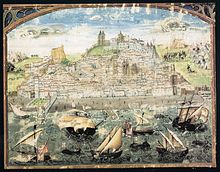
When the Spaniards expelled the Jews from Spanish territory, many of them fled to Lisbon. Although acknowledging the central importance of the Jews to the city's prosperity,Manuel Idecreed in 1497 that all Jews must convert to Christianity, only those who refused being forced to leave, but not before the expropriation of their property.[47]In 1506, an anti-semitic movement among theOld Christiansof Lisbon culminated in a massacre lasting four days in which some 1,000 to 4,000New Christianmen, women and children, converted descendants ofSephardic Jews,are estimated to have been killed.[48]The king was at Évora when these events occurred, but angered when he received the news, he ordered an investigation which resulted in two of the instigating friars being excommunicated and burned alive.[49]
Most of the Portuguese expeditions of theAge of Discoveryset out from Lisbon during the period from the end of the 15th century to the beginning of the 17th century, includingVasco da Gama's expedition toIndiain 1498. The following years of the 16th century began Lisbon's golden era: the city was the European hub of commerce betweenAfrica,India,theFar Eastand later,Brazil,and acquired great riches by exploiting the trade in spices, slaves, sugar, textiles and other goods. This period saw the rise of the exuberantManuelinestyle in architecture, which left its mark in many 16th-century monuments (including Lisbon'sBelém TowerandJerónimos Monastery,which were declaredUNESCO World Heritage Sites). A description of Lisbon in the 16th century was written byDamião de Góisand published in 1554.[50]


Thesuccession crisisof 1580, initiated a sixty-year period of dual monarchy in Portugal and Spain under theSpanish Habsburgs.[51][52]This is referred to as the "Philippine Dominion" (Domínio Filipino), since allthree Spanish kingsduring that period were called Philip (Filipe). In 1589, Lisbon was the target of an incursion by theEnglish Armadaled byFrancis Drake,whileQueen Elizabethsupported a PortuguesepretenderinAntonio, Prior of Crato,but support for Crato was lacking and the expedition was a failure. ThePortuguese Restoration War,which began with acoup d'étatorganised by the nobility andbourgeoisiein Lisbon and executed on 1 December 1640, restored Portuguese independence. The period from 1640 to 1668 was marked by periodic skirmishes between Portugal and Spain, as well as short episodes of more serious warfare until theTreaty of Lisbonwas signed in 1668.
In the early 18th century, gold from Brazil allowedKing John Vto sponsor the building of severalBaroquechurches and theatres in the city. Prior to the 18th century, Lisbon had experienced several significant earthquakes – eight in the 14th century, five in the 16th century (including the1531 earthquakethat destroyed 1,500 houses and the 1597 earthquake in which three streets vanished), and three in the 17th century.
On 1 November 1755, the city was destroyed by anotherdevastating earthquake,which killed an estimated 30,000 to 40,000 Lisbon residents[53]of a population estimated at between 200,000 and 275,000,[54][55]and destroyed 85 percent of the city's structures.[56]Among several important buildings of the city, theRibeira Palaceand theHospital Real de Todos os Santoswere lost. In coastal areas, such asPeniche,situated about 80 km (50 mi) north of Lisbon, many people were killed by the followingtsunami.
By 1755, Lisbon was one of the largest cities in Europe; the catastrophic event shocked the whole of Europe and left a deep impression on its collective psyche.Voltairewrote a long poem,Poême sur le désastre de Lisbonne,shortly after the quake, and mentioned it in his 1759 novelCandide(indeed, many argue that this critique ofoptimismwas inspired by that earthquake).Oliver Wendell Holmes Sr.also mentions it in his 1857 poem,The Deacon's Masterpiece, or The Wonderful One-Hoss Shay.
After the 1755 earthquake, the city was rebuilt largely according to the plans of Prime MinisterSebastião José de Carvalho e Melo,the1st Marquis of Pombal;the lower town began to be known as theBaixa Pombalina(Pombaline central district). Instead of rebuilding the medieval town, Pombal decided to demolish what remained after the earthquake and rebuild the city centre in accordance with principles of modern urban design. It was reconstructed in an open rectangular plan with two great squares: thePraça do Rossioand thePraça do Comércio.The first, the central commercial district, is the traditional gathering place of the city and the location of the older cafés, theatres and restaurants; the second became the city's main access to the River Tagus and point of departure and arrival for seagoing vessels, adorned by a triumphal arch (1873) and a monument to KingJoseph I.
Modern era[edit]
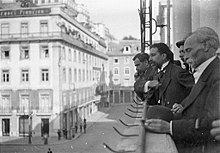
In the first years of the 19th century, Portugal was invaded by the troops ofNapoléon Bonaparte,forcing QueenMaria Iand Prince-RegentJohn(future John VI) to flee temporarily to Brazil. By the time the new King returned to Lisbon, many of the buildings and properties were pillaged, sacked or destroyed by the invaders.
During the 19th century, the Liberal movement introduced new changes into the urban landscape. The principal areas were in theBaixaand along theChiadodistrict, where shops, tobacconists shops, cafés, bookstores, clubs and theatres proliferated. The development of industry and commerce determined the growth of the city, seeing the transformation of thePasseio Público,a Pombaline era park, into theAvenida da Liberdade,as the city grew farther from the Tagus.
Lisbon was the site of theregicideofCarlos I of Portugalin 1908, an event which culminated two years later in the establishment of the First Republic.

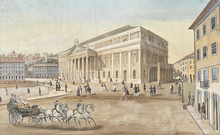
The city refounded its university in 1911 after centuries of inactivity in Lisbon, incorporating reformed former colleges and other non-university higher education schools of the city (such as theEscola Politécnica– nowFaculdade de Ciências). Today there are two public universities in the city (University of LisbonandNew University of Lisbon), a public university institute (ISCTE - Lisbon University Institute) and apolytechnicinstitute (IPL –Instituto Politécnico de Lisboa).
DuringWorld War II,Lisbon was one of the very few neutral, open European Atlantic ports, a major gateway for refugees to the U.S. and a haven for spies. More than 100,000 refugees were able to fleeNazi Germanyvia Lisbon.[57]
During theEstado Novoregime (1926–1974), Lisbon, under the influence ofDuarte Pacheco,the minister of works, was expanded at the cost of other districts within the country, resulting in nationalist and monumental projects. New residential and public developments were constructed; the zone ofBelémwas modified for the1940 Portuguese Exhibition,while along the periphery new districts appeared to house the growing population. The inauguration of the bridge over the Tagus allowed a rapid connection between both sides of the river.
Lisbon was the site of three revolutions in the 20th century. The first, the5 October 1910 revolution,brought an end to thePortuguese monarchyand established the highly unstable and corruptPortuguese First Republic.The6 June 1926 revolutionended the first republic and firmly established theEstado Novo,or thePortuguese Second Republic,as the ruling regime.
Contemporary[edit]
TheCarnation Revolution,which took place on 25 April 1974, ended the right-wingEstado Novoregime and reformed the country to become as it is today, thePortuguese Third Republic.
In the 1990s, many of the districts were renovated and projects in the historic quarters were established to modernise those areas, for instance, architectural and patrimonial buildings were renovated, the northern margin of the Tagus was re-purposed for leisure and residential use, theVasco da Gama Bridgewas constructed and the eastern part of the municipality was re-purposed forExpo '98to commemorate the 500th anniversary ofVasco da Gama's sea voyage to India, a voyage that would bring immense riches to Lisbon and cause many of Lisbon's landmarks to be built.
In 1988, a fire in the historical district ofChiadosaw the destruction of many 18th-centuryPombaline stylebuildings. A series of restoration works has brought the area back to its former self and made it a high-scale shopping district.

TheLisbon Agendawas a European Union agreement on measures to revitalise the EU economy, signed in Lisbon in March 2000. In October 2007 Lisbon hosted the2007 EU Summit,where an agreement was reached regarding a new EU governance model. The resultingTreaty of Lisbonwas signed on 13 December 2007 and came into force on 1 December 2009.
Lisbon has been the site for many international events and programmes. In 1994, Lisbon was theEuropean Capital of Culture.On 3 November 2005, Lisbon hosted theMTV European Music Awards.On 7 July 2007, Lisbon held the ceremony of the "New 7 Wonders Of The World"[58]election, in theLuz Stadium,with live transmission for millions of people all over the world. Every two years, Lisbon hosts theRock in Rio LisboaMusic Festival, one of the largest in the world. Lisbon hosted theNATOsummit (19–20 November 2010), asummit meetingthat is regarded as a periodic opportunity for Heads of State andHeads of GovernmentofNATO member statesto evaluate and provide strategic direction for Alliance activities.[59]The city hosts theWeb Summitand is the head office for theGroup of Seven Plus (G7+).In 2018 it hosted theEurovision Song Contestfor the first time as well as theMichelin Gala.[60]On 11 July 2018, theAga Khanofficially chose the Henrique de Mendonça Palace, located on Rua Marquês de Fronteira, as theDivan,or seat, of the globalNizari MuslimImamate.[61][62]Lisbon hostedWorld Youth Day 2023in August of that year, attractingCatholicyouth from the around the world.Pope Francisled several events, with the finalmassheld in the city's Parque do Tejo having an estimated 1.5 million attendees.[63][64][65]
Geography[edit]

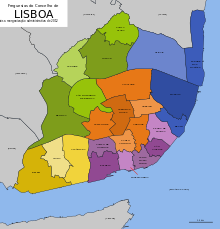
Physical geography[edit]
Lisbon is located at38°42′49.75″N9°8′21.79″W/ 38.7138194°N 9.1393861°W,situated at the mouth of theTagus Riverand is the westernmost capital of a mainland European country. The river delta isinverted.
The westernmost part of Lisbon is occupied by theMonsanto Forest Park,a 10 km2(4 sq mi) urban park, one of the largest in Europe, and occupying 10% of the municipality.
The city occupies an area of 100.05 km2(39 sq mi), and its city boundaries, unlike those of most major cities, coincide with those of the municipality.[66]The rest of the urbanised area of the Lisbon urban area, known generically asGreater Lisbon(Portuguese:Grande Lisboa) includes several administratively defined cities and municipalities, in the north bank of the Tagus River. The largerLisbon metropolitan areaincludes theSetúbal Peninsulato the south.
Climate[edit]
Lisbon has aMediterranean climate(Köppen:Csa)[67]with mild, rainy winters and warm to hot, dry summers. The average annual temperature is 17.4 °C (63.3 °F), 21.3 °C (70.3 °F) during the day and 13.5 °C (56.3 °F) at night.
In the coldest month – January – the highest temperature during the day typically ranges from 11 to 19 °C (52 to 66 °F), the lowest temperature at night ranges from 3 to 13 °C (37 to 55 °F) and the average sea temperature is 16 °C (61 °F).[68]In the warmest month – August – the highest temperature during the day typically ranges from 25 to 32 °C (77 to 90 °F), the lowest temperature at night ranges from 14 to 20 °C (57 to 68 °F) and the average sea temperature is around 20 °C (68 °F).[68]
Among European capitals, Lisbon ranks among those with the warmest winters and has the mildest winter nights out of any major European city, with an average of 8.3 °C (46.9 °F) in the coldest month, and 18.6 °C (65.5 °F) in the warmest month. The coldest temperature ever recorded in Lisbon was −1.2 °C (30 °F) in February 1956; although other locations in itsmetropolitan areacan record lower temperatures, not being as affected by theurban heat islandof the city centre, withSintraandSetúbalhaving reached −4 °C (25 °F) and −5.1 °C (23 °F) respectively, both experiencing about 13 days of frost per year on average.[69][70]The highest temperature ever recorded in Lisbon was 44.0 °C (111.2 °F) on 4 August 2018.[71]
The city has around 2,806 hours of sunshine per year, averaging 4.6 hours of sunshine per day in December and 11.4 hours of sunshine per day in July, though when disregarding the duration of the day August is actually the sunniest, with over 80% chance of direct sunlight hitting the ground.[72]
Lisbon has around 750 mm (30 in) of precipitation per year. November and December are the wettest months, accounting for a third of the total annual precipitation. July and August are the driest.[73]
| Climate data for Lisbon(altitude: 77m.a.s.l.,~1km from sea,location on map) | |||||||||||||
|---|---|---|---|---|---|---|---|---|---|---|---|---|---|
| Month | Jan | Feb | Mar | Apr | May | Jun | Jul | Aug | Sep | Oct | Nov | Dec | Year |
| Record high °C (°F) | 22.6 (72.7) |
24.8 (76.6) |
29.4 (84.9) |
32.4 (90.3) |
34.8 (94.6) |
41.5 (106.7) |
40.6 (105.1) |
44.0 (111.2) |
41.4 (106.5) |
32.6 (90.7) |
25.3 (77.5) |
23.2 (73.8) |
44.0 (111.2) |
| Mean daily maximum °C (°F) | 14.8 (58.6) |
16.2 (61.2) |
18.8 (65.8) |
19.8 (67.6) |
22.1 (71.8) |
25.7 (78.3) |
27.9 (82.2) |
28.3 (82.9) |
26.5 (79.7) |
22.5 (72.5) |
18.2 (64.8) |
15.3 (59.5) |
21.3 (70.4) |
| Daily mean °C (°F) | 11.6 (52.9) |
12.7 (54.9) |
14.9 (58.8) |
15.9 (60.6) |
18.0 (64.4) |
21.2 (70.2) |
23.1 (73.6) |
23.5 (74.3) |
22.1 (71.8) |
18.8 (65.8) |
15.0 (59.0) |
12.4 (54.3) |
17.4 (63.4) |
| Mean daily minimum °C (°F) | 8.3 (46.9) |
9.1 (48.4) |
11.0 (51.8) |
11.9 (53.4) |
13.9 (57.0) |
16.6 (61.9) |
18.2 (64.8) |
18.6 (65.5) |
17.6 (63.7) |
15.1 (59.2) |
11.8 (53.2) |
9.4 (48.9) |
13.5 (56.2) |
| Record low °C (°F) | 1.0 (33.8) |
−1.2 (29.8) |
0.2 (32.4) |
5.5 (41.9) |
6.8 (44.2) |
10.4 (50.7) |
14.1 (57.4) |
14.7 (58.5) |
12.1 (53.8) |
9.2 (48.6) |
4.3 (39.7) |
2.1 (35.8) |
−1.2 (29.8) |
| Average rainfall mm (inches) | 99.9 (3.93) |
84.9 (3.34) |
53.2 (2.09) |
68.1 (2.68) |
53.6 (2.11) |
15.9 (0.63) |
4.2 (0.17) |
6.2 (0.24) |
32.9 (1.30) |
100.8 (3.97) |
127.6 (5.02) |
126.7 (4.99) |
774 (30.47) |
| Average rainy days(≥ 0.1 mm) | 15.0 | 15.0 | 13.0 | 12.0 | 8.0 | 5.0 | 2.0 | 2.0 | 6.0 | 11.0 | 14.0 | 14.0 | 117 |
| Mean monthlysunshine hours | 142.6 | 156.6 | 207.7 | 234.0 | 291.4 | 303.0 | 353.4 | 344.1 | 261.0 | 213.9 | 156.0 | 142.6 | 2,806.3 |
| Source:Instituto Português do Mar e da Atmosfera,[73]Hong Kong Observatory[74]for data of avg. precipitation days & sunshine hours | |||||||||||||
Freguesias[edit]
The municipality of Lisbon included 53freguesiasuntil November 2012. A new law ( "Lei n.º 56/2012" ) reduced the number offreguesiasto the following 24:[75]
Neighborhoods[edit]
Locally, Lisbon's inhabitants may commonly refer to the spaces of Lisbon in terms of historicBairros de Lisboa(neighbourhoods). These communities have no clearly defined boundaries and represent distinctive quarters of the city that have in common a historical culture, similar living standards, and identifiable architectural landmarks, as exemplified by theBairro Alto,Alfama,Chiado,and so forth.
Alcântara[edit]
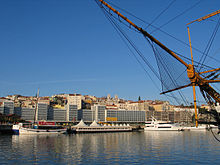
Although today it is quite central, it was once a mere suburb of Lisbon, comprising mostly farms and country estates of the nobility with their palaces. In the 16th century, there was a brook there which the nobles used to promenade in their boats. During the late 19th century, Alcântara became a popular industrial area, with many small factories and warehouses.
In the early 1990s, Alcântara began to attract youth because of the number of pubs and discothèques. This was mainly due to its outer area of mostly commercial buildings, which acted as barriers to the noise-generating nightlife (which acted as a buffer to the residential communities surrounding it). In the meantime, some of these areas began to become gentrified, attracting loft developments and new flats, which have profited from its river views and central location.
The riverfront of Alcântara is known for its nightclubs and bars. The area is commonly known asdocas(docks), since most of the clubs and bars are housed in converted dock warehouses.
Alfama[edit]

The oldest district of Lisbon, it spreads down the southern slope from theCastle of São Jorgeto theRiver Tagus.Its name, derived from theArabicAl-hamma,means fountains or baths. During theIslamic invasion of Iberia,the Alfama constituted the largest part of the city, extending west to theBaixaneighbourhood. Increasingly, the Alfama became inhabited by fishermen and the poor: its fame as a poor neighbourhood continues to this day. While the1755 Lisbon earthquakecaused considerable damage throughout the capital, the Alfama survived with little damage, thanks to its compact labyrinth of narrow streets and small squares.

It is a historical quarter of mixed-use buildings occupied byFadobars, restaurants, and homes with small shops downstairs. Modernising trends have invigorated the district: old houses have been re-purposed or remodelled, while new buildings have been constructed. Fado, the typically Portuguese style of melancholy music, is common (but not obligatory) in the restaurants of the district.
Mouraria[edit]
The Mouraria, or Moorish quarter, is one of the most traditional neighbourhoods of Lisbon,[76]although most of its old buildings were demolished by theEstado Novobetween the 1930s and the 1970s.[77]It takes its name from the fact that after the reconquest of Lisbon, the Muslims who remained were confined to this part of the city.[78]In turn, the Jews were confined to three neighbourhoods called "Judiarias".[79]
Bairro Alto[edit]

Bairro Alto (literallythe upper quarterinPortuguese) is an area of central Lisbon that functions as a residential, shopping and entertainment district; it is the center of the Portuguese capital's nightlife, attracting hipster youth and members of various music subcultures. Lisbon'spunk,gay,metal,goth,hip hopandreggaescenes all find a home in theBairrowith its many clubs and bars that cater to them. The crowds in the Bairro Alto are a multicultural mix of people representing a broad cross-section of modern Portuguese society, many of them being entertainment seekers and devotees of various music genres outside the mainstream,Fado,Portugal's national music, still survives in the midst of the new nightlife.
Baixa[edit]
The heart of the city is theBaixaor city centre; the Pombaline Baixa is an elegant district, primarily constructed after the1755 Lisbon earthquake,taking its name from its benefactor,Sebastião José de Carvalho e Melo, 1st Marquis of Pombal,who was the minister ofJoseph I of Portugal(1750–1777) and a key figure during the PortugueseEnlightenment.Following the 1755 disaster, Pombal took the lead in rebuilding Lisbon, imposing strict conditions and guidelines on the construction of the city, and transforming the organic street plan that characterised the district before the earthquake into its current grid pattern. As a result, the Pombaline Baixa is one of the first examples ofearthquake-resistant construction.Architectural models were tested by having troops march around them to simulate an earthquake. Notable features of Pombaline structures include the Pombaline cage, a symmetrical wood-lattice framework aimed at distributing earthquake forces, and inter-terrace walls that were built higher than roof timbers to inhibit the spread of fires.
Beato[edit]

The parish ofBeatostands out for the new cultural dynamics it has been experiencing in recent years. The manufacturing districts and the industrial facilities by the riverside docks are the place of choice for contemporary art galleries, iconic bars, and gourmet restaurants that simmer in the streets. This reality has not gone unnoticed by the national press, and Visão,[80]TimeOut,[81]or Jornal de Negócios[82]have already made notice of this parish that hides treasures such as theNational Museum of the Azulejoor thePalacio do Grilo.
Belém[edit]
Belém is famous as the place from which many of the greatPortugueseexplorers set off on their voyages of discovery. In particular, it is the place from whichVasco da Gamadeparted forIndiain 1497 and Pedro Álvares Cabral departed for Brazil in 1499. It is also a former royal residence and features the 17th – 18th-centuryBelém Palace,a former royal residence now occupied by thePresident of Portugal,and theAjuda Palace,begun in 1802 but never completed.
Perhaps Belém's most famous feature is its tower,Torre de Belém,whose image is much used by Lisbon's tourist board. The tower was built as a fortified lighthouse late in the reign ofDom Manuel l(1515–1520) to guard the entrance to the port. It stood on a little island on the right side of theTagus,surrounded by water. Belém's other major historical building is theMosteiro dos Jerónimos(Jerónimos Monastery), which theTorre de Belémwas built partly to defend. Belém's most notable modern feature is thePadrão dos Descobrimentos(Monument to the Discoveries) built for the Portuguese World Fair in 1940. In the heart of Belém is thePraça do Império:gardens centred upon a large fountain, laid out duringWorld War II.To the west of the gardens lies theCentro Cultural de Belém.Belém is one of the most visited Lisbon districts. Here is located theEstádio do Restelo,home toBelenenses.
Chiado[edit]

The Chiado is a traditional shopping area that mixes old and modern commercial establishments, concentrated specially in the Rua do Carmo and the Rua Garrett. Locals as well as tourists visit the Chiado to buy books, clothing and pottery as well as to have a cup of coffee. The most famous café of Chiado isA Brasileira,famous for having had poetFernando Pessoaamong its customers. The Chiado is also an important cultural area, with several museums and theatres, including the opera. Several buildings of the Chiado were destroyed in a fire in 1988, an event that deeply shocked the country. Thanks to a renovation project that lasted more than 10 years, coordinated by celebrated architectSiza Vieira,the affected area has now virtually recovered.
Estrela[edit]
The ornate, late 18th-centuryEstrela Basilicais the main attraction of this district. The church with its large dome is located on a hill in what was at the time the western part of Lisbon and can be seen from great distances. The style is similar to that of theMafra National Palace,late baroque and neoclassical. The façade has twin bell towers and includes statues of saints and some allegorical figures.São Bento Palace,the seat of the Portuguese parliament and the official residences of thePrime Minister of Portugaland the President of theAssembly of the Republic of Portugal,are in this district. Also in this district is Estrela Park, a favorite with families. There are exotic plants and trees, a duck pond, various sculptures, a children's playground, and many cultural events going on throughout the year, including outdoor cinema, markets, and music festivals.
Parque das Nações[edit]

Parque das Nações (Park of Nations) is the newest district in Lisbon; it emerged from an urban renewal program to host the 1998 World Exhibition of Lisbon, also known as Expo'98. The area suffered massive changes giving Parque das Nações a futuristic look. A long-lasting legacy of the same, the area has become another commercial and higher-end residential area for the city.
Central in the area is theGare do Oriente(Orient railway station), one of the main transport hubs of Lisbon for trains, buses, taxis, and the metro. Its glass and steel columns are inspired by Gothic architecture, lending the whole structure a visual fascination (especially in sunlight or when illuminated at night). It was designed by the architectSantiago CalatravafromValencia,Spain. The Parque das Nações is across the street.
The area is pedestrian-friendly with new buildings, restaurants, gardens, theCasino Lisbon,the FIL building (International Exhibition and Fair), the Camões Theatre and theOceanário de Lisboa(Lisbon Oceanarium), which is the second-largest in the world. The district'sAltice Arenahas become Lisbon's "jack-of-all-trades" performance arena. With seating for 20,000, it has staged events ranging from concerts to basketball tournaments.
Politics[edit]


PSD/CDS/A/MPT/PPM(7)
PS/L(7)
CDU(2)
BE(1)
Carlos Moedas(PSD) took office as the 78th and currentMayor of Lisbonon 18 October 2021, following the2021 local elections.
Local election results 1976–2021[edit]
| Election | PCP | PS | PSD | CDS | PPM | APU | CDU | BE | CR | HR | PAN | IL | CH | O/I* | Turnout |
|---|---|---|---|---|---|---|---|---|---|---|---|---|---|---|---|
| 1976 | 20.7 | 35.5 | 15.2 | 19.0 | 0.4 | - | - | - | - | - | - | - | - | 9.1 | 66.5 |
| 1979 | - | 23.4 | 46.7 | 25.1 | - | - | - | - | - | - | - | 4.9 | 75.6 | ||
| 1982 | - | 27.0 | 41.3 | 26.7 | - | - | - | - | - | - | - | 5.1 | 72.2 | ||
| 1985 | - | 18.0 | 44.8 | - | 5.1 | 27.5 | - | - | - | - | - | - | - | 4.7 | 58.7 |
| 1989 | - | 49.1 | 42.1 | - | w.PS | - | - | - | - | - | - | 8.9 | 54.8 | ||
| 1993 | - | 56.7 | 26.4 | 7.8 | - | - | w.PS | - | - | - | - | - | - | 9.3 | 53.5 |
| 1997 | - | 51.9 | 39.3 | - | - | w.PS | - | - | - | - | - | - | 8.8 | 48.3 | |
| 2001 | - | 41.7 | 42.0 | 7.6 | w.PSD | - | w.PS | 3.8 | - | - | - | - | - | 4.9 | 55.0 |
| 2005 | - | 26.6 | 42.4 | 5.9 | - | - | 11.4 | 7.9 | - | - | - | - | - | 5.9 | 52.7 |
| 2007 | - | 29.5 | 15.7 | 3.7 | 0.4 | - | 9.5 | 6.8 | 16.7 | 10.2 | - | - | - | 7.8 | 37.4 |
| 2009 | - | 44.0 | 38.7 | - | 8.1 | 4.6 | - | - | - | - | - | 4.7 | 53.4 | ||
| 2013 | - | 50.9 | 22.4 | 1.2 | - | 9.9 | 4.6 | - | - | 2.3 | - | - | 8.7 | 45.1 | |
| 2017 | - | 42.0 | 11.2 | 20.6 | - | 9.6 | 7.1 | - | - | 3.0 | - | - | 6.5 | 51.2 | |
| 2021 | - | 33.3 | 34.3 | - | 10.5 | 6.2 | - | - | 2.7 | 4.2 | 4.4 | 4.4 | 51.0 | ||
| *O/I: Other parties and Invalid/Blank votes. | |||||||||||||||
| Source:Comissão Nacional de EleiçõesArchived25 January 2011 at theWayback Machine | |||||||||||||||
Culture[edit]


The city of Lisbon is rich in architecture;Romanesque,Gothic,Manueline,Baroque,ModernandPostmodernconstructions can be found all over Lisbon. The city is also crossed by historical boulevards and monuments along the main thoroughfares, particularly in the upper districts; notable among these are theAvenida da Liberdade(Avenue of Liberty),Avenida Fontes Pereira de Melo,Avenida Almirante ReisandAvenida da República(Avenue of the Republic).
Lisbon is home to numerous prominent museums and art collections, from all around the world. TheNational Museum of Ancient Art,which has one of thelargest art collections in the world,and theNational Coach Museum,which has the world's largest collection of royal coaches and carriages, are the two most visited museums in the city. Other notable national museums include theNational Museum of Archaeology,theMuseum of Lisbon,theNational Azulejo Museum,theNational Museum of Contemporary Art,and theNational Museum of Natural History & Science.
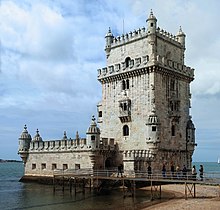
Prominent private museums and galleries include theGulbenkian Museum(run by theCalouste Gulbenkian Foundation,one of thewealthiest foundations in the world), which houses one of the largest private collections of antiquities and art in the world, theBerardo Collection Museum,which houses the private collection of Portuguese billionaireJoe Berardo,theMuseum of Art, Architecture and Technology,and theMuseum of the Orient.Other popular museums include theElectricity Museum,theEphemeral Museum,theMuseu da Água,and theMuseu Benfica,among many others.
Lisbon's Opera House, theTeatro Nacional de São Carlos,hosts a relatively active cultural agenda, mainly in autumn and winter. Other important theatres and musical houses are theCentro Cultural de Belém,theTeatro Nacional D. Maria II,theGulbenkian Foundation,and theTeatro Camões.
The monument toChrist the King(Cristo-Rei) stands on the southern bank of the Tagus River, inAlmada.With open arms, overlooking the whole city, it resembles the Corcovado monument inRio de Janeiro,and was built afterWorld War II,as a memorial of thanksgiving for Portugal's being spared the horrors and destruction of the war.

13 June is Lisbon's holiday in honour of the city's saint,Anthony of Lisbon(Portuguese:Santo António). Saint Anthony, also known asSaint Anthony of Padua,was a wealthy Portuguese bohemian who wascanonisedand madeDoctor of the Churchafter a life preaching to the poor. Although Lisbon's patron saint is SaintVincent of Saragossa,whose remains are housed in theSé Cathedral,there are no festivities associated with this saint.
Eduardo VII Park,the second-largest park in the city following theParque Florestal de Monsanto(Monsanto Forest Park), extends down the main avenue (Avenida da Liberdade), with many flowering plants and green spaces, that includes the permanent collection of subtropical and tropical plants in the winter garden (Portuguese:Estufa Fria). Originally namedParque da Liberdade,it was renamed in honour ofEdward VIIwho visited Lisbon in 1903.

Lisbon is home every year to theLisbon Gay & Lesbian Film Festival,[83]the Lisboarte, the DocLisboa – Lisbon International Documentary Film Festival,[84]the Festival Internacional de Máscaras e Comediantes, the Lisboa Mágica – Street Magic World Festival, the Monstra – Animated Film Festival, theLisbon Book Fair,[85]the Peixe em Lisboa – Lisbon Fish and Flavours,[86]and many others.
Lisbon has two sites listed byUNESCOas aWorld Heritage Site:Belém TowerandJerónimos Monastery.Furthermore, in 1994, Lisbon was theEuropean Capital of Cultureand, in 1998, organised theExpo '98(1998 Lisbon World Exposition).
Lisbon is also home to the Lisbon Architecture Triennial,[87]the Moda Lisboa (Fashion Lisbon),[88]ExperimentaDesign – Biennial of Design,[89]and LuzBoa – Biennial of Light.[90]
Lisbon hosts many fine examples of Portugueseazulejotile art, a use of ceramic tile as an architectural finish for both building interiors and exteriors dating from the 15th Century. This art form is celebrated in Lisbon'sNational Museum of the Azulejoand as a station feature in theLisbon metro.In addition, the mosaicPortuguese pavement(Calçada Portuguesa) was born in Lisbon, in the mid-1800s. The art has since spread to the rest of the Portuguese Speaking world. The city remains one of the most expansive examples of the technique, nearly all walkways and even many streets being created and maintained in this style.
In May 2018, the city hosted the63rd edition of the Eurovision Song Contest,after the victory ofSalvador Sobralwith the song "Amar pelos dois"inKyivon 13 May 2017.
World Youth Day 2023was hosted in August of that year in Lisbon, attracting hundreds of thousands of young Catholics from over 140 countries.[91]
Demographics[edit]
|
| ||||||||||||||||||||||||||||||||||||||||||||||||||||||||||||||||||||||||||||||||||||
| Source:INE[92] | |||||||||||||||||||||||||||||||||||||||||||||||||||||||||||||||||||||||||||||||||||||
The historical population of the city was around 35,000 in 1300. This number went up to 60,000 in 1400, and raised to 70,000 by 1500. Between 1528 and 1590 the population went from 70,000 to 120,000. The population was about 150,000 in 1600, and almost 200,000 in 1700.[93][94][95]
Lisbon has 567,131 inhabitants within the administrative center on the area of only 100.05 km2[4]The population density of the city itself is 5,668.5/km2(14,681/sq mi).
The Lisbon metropolitan area incorporates twoNUTS III(European statistical subdivisions):Grande Lisboa(Greater Lisbon), along the northern bank of theTagus River,andPenínsula de Setúbal(Setúbal Peninsula), along the southern bank. These two subdivisions make for theRegião de Lisboa(Lisbon Region).

Administratively defined cities that exist in the vicinity of the capital are in fact part of the metropolitan perimeter of Lisbon. The urban area has, according to Government data, a population of approximately 2.96 million inhabitants and is the eleventh largest urban area in the European Union.[12][11]Other sources also show similar figures: according to theOrganisation for Economic Co-operation and Developmentthe area had 2,797,612 inhabitants;[96]according to the Department of Economic and Social Affairs of theUnited Nations2,890,000;[97]according to the European Statistical OfficeEurostat2,839,908[98]and according to theBrookings Institution2,968,600.[99]
Religion[edit]
Religion in the municipality of Lisbon (Census 2021)[100]
The largest religion is, according to 2021 Portuguese Census,Roman Catholicism.The proportion of Catholics in Lisbon city proper (around 66%) is significantly higher than in the city's metropolitan area (55%).[101]This may due to the fact that Lisbon city's age structure is older than the one found in the surrounding areas and, in general, younger generations tend to be less religious.[102][103]
Immigration[edit]
In 2022, around 21.7% of the city's population is constituted by foreign nationals, with Brazilians being the largest resident foreign community, followed by Italians, French, Nepalis and Bangladeshis.
Lisbon's population has steadily dropped over the years due to people searching better accommodations for lower prices elsewhere in Greater Lisbon. In addition, a plurality of the houses in the city centre have become tourist facilities, exacerbating the lack of offer in Lisbon's housing market.[104][105][106][107]
| Largest groups of foreign residents in 2022[108][109] | |
| Nationality | Population |
|---|---|
| 22,080 | |
| 9,391 | |
| 9,033 | |
| 8,875 | |
| 8,486 | |
Economy[edit]

TheLisbon regionis the wealthiest region in Portugal and it is well above theEuropean Union'sGDP per capitaaverage – it produces 45% of the Portuguese GDP.
The Lisbon region is rapidly growing, with GDP (PPP) per capita calculated for each year as follows: €22,745 (2004)[110]– €23,816 (2005)[111]– €25,200 (2006)[112]– €26,100 (2007).[113]The Lisbon metropolitan area had aGDP amounting to $110.4 billion,and $32,434 per capita.[114]

Lisbon's economy is based primarily on thetertiary sector.Most of the headquarters of multinationals operating in Portugal are concentrated in theGrande Lisboa Subregion,especially in theOeirasmunicipality. TheLisbon metropolitan areais heavily industrialized, especially the south bank of theTagusriver (Rio Tejo). The lisbonite industry has very large sectors in oil, as refineries are found just across the Tagus, textile mills, shipyards and fishing.
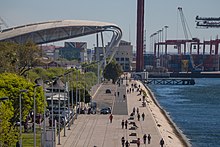
The country's chiefseaport,featuring one of the largest and most sophisticated regional markets on the Iberian Peninsula, Lisbon and its heavily populated surroundings are also developing as an important financial centre and a dynamic technological hub. Automobile manufacturers have erected factories in the suburbs, for example,AutoEuropa.
Lisbon has the largest and most developed mass media sector of Portugal and is home to several related companies ranging from leading television networks and radio stations tomajor newspapers.Based in Lisbon,Euronext Lisbonis astock exchangewhich is part of the pan-EuropeanEuronextsystem of stock exchanges and market infrastructure.[116]
Before Portugal's sovereign debt crisis and anEU-IMF rescue plan,for the decade of 2010 Lisbon was expecting to receive many state-funded investments, including building a new airport, a new bridge, an expansion of the Lisbon Metro 30 km (18.64 mi) underground, the construction of a mega-hospital (or central hospital), the creation of two lines of aTGVto joinMadrid,Porto,Vigoand the rest of Europe, the restoration of the main part of the town (between the Marquês de Pombal roundabout and Terreiro do Paço), the creation of a large number of bike lanes, as well as modernization and renovation of various facilities.[117]
Lisbon was the7th most "livable city" in the worldin 2021 according to lifestyle magazineMonocle.[118]
Tourism is also a significant industry. The city is the ninth-most-visited city inSouthern Europe,afterIstanbul,Rome,Barcelona,Milan,Athens,Venice,MadridandFlorencewith 3,639,900 tourists in 2019.[119][120][121]In 2022 there were around 6 tourists for every resident.[122]The city is popular for both leisure and business tourism.[123][124]Around 7.7 million tourists visited Lisbon region in 2022 alone, with 71.1% of them being international tourists.[125]It is estimated that tourist receipts will stand at 17.4 billion euros (€) in 2023.[126]
Transport[edit]
Metro[edit]

TheLisbon Metroconnects the city centre with the upper and eastern districts, and also reaches some suburbs that are part of theLisbon metropolitan area,such asAmadoraandLoures.It is the fastest way to get around the city and it provides a good number of interchanging stations with other types of transportation. From theLisbon Airportstation to the city centre it may take roughly 25 mins. In 2019, theLisbon Metroserved around 173 million passengers (and 475.000 daily). As of 2018, theLisbon Metrocomprises four lines, identified by individual colours (blue, yellow, green and red) and 56 stations, with a total length of 44.2 km. Several expansion projects have been proposed, the most recent being the transformation of the Green Line into a circular line and the creation of two more stations (Santos andEstrela).
Trams[edit]

Thetramis a traditional form of public transport in Lisbon. Introduced in 1901, electric trams were originally imported from the US,[127]and thus called theamericanos(Portuguesefor "American" ).
Other than on the modern Line 15, theLisbon tramway systemstill employs small (four-wheel) vehicles of a design dating from the early twentieth century. These distinctive yellow trams are one of the tourist icons of modern Lisbon, and their size is well suited to the steep hills and narrow streets of the central city.[128][129]
The earliest trams can still be seen in theMuseu da Carris(the Lisbon Public Transport Museum).
The line has now a total length of 31 kilometers operating on 6 lines, down from a maximum of 76 kilometers for 27 lines. The slow decline of the network began with the construction of theLisbon Metroand the expansion of thebus system.[130]Starting in 2017 the system has been expanded and new vehicles are being progressively added, aiming at expanding significantly the current tramway system.[131][132][133]There are currently 64 trams in operation in Lisbon and, during 2023-2026, 35 more will be added (Of which 10 will be "Historical models" ).[134][135][136][137]
Trains[edit]

There are fourcommuter trainlines departing from Lisbon: the Sintra, Azambuja, Cascais and Sado lines (operated by CP –Comboios de Portugal), as well as a fifth line toSetúbal(operated byFertagus), which crosses theTagusriver via the25 de Abril Bridge.The major railway stations areSanta Apolónia,Rossio,Gare do Oriente,Entrecampos,andCais do Sodré.
Buses[edit]
The local bus service within Lisbon is operated byCarris.Carris' fleet includes 741 buses and, in the period 2023-2026, other 342 buses will be added so as to increase the public transportation system reach.[138][137]Thebus networkhas a length of 748 km comprising 99 bus routes.[139]Major investments have been made in recent years: for instance, in 2017 there were 600 buses operating on 674 km and 75 routes: 141 buses, 74 kilometers and 24 bus routes were added in 2018-2022.[140]
Outside Lisbon, there are two main commuter bus services connecting the cities outside Lisbon amongst them and to Lisbon: Carris Metropolitana,[141]a brand operated by 4 companies, all operating inside the Lisbon Metropolitan Area, and Barraqueiro Transportes[142](with 4 brands operating outside the Metropolitan Area with services to Lisbon), which operate from different terminals in the city.
Bridges[edit]


The city is connected to the far side of the Tagus by two important bridges:
- The25 de Abril Bridge,inaugurated (as PonteSalazar) on 6 August 1966, and later renamed after the date of theCarnation Revolution,was the longestsuspension bridgein Europe.[143]
- TheVasco da Gama Bridge,opened on 29 March 1998 is, at 17.2 km (10.7 mi), the longest bridge in Europe.[144]
The foundations for athird bridge across the Tagushave already been laid, but the overall project has been postponed due to the economic crisis in Portugal and all of Europe.[145][146]
Ferries[edit]
Another way of crossing the river is by taking the ferry. The operatorTranstejo & Soflusa,[147]runs to different locations from within the city:Cacilhas,Seixal,Montijo,Porto BrandãoandTrafariaunder the brand Transtejo and toBarreirounder the brand Soflusa. Ferry stations in Lisbon includeBelém River Station,Terreiro do Paço River StationandCais do Sodré River Station.
Air travel[edit]
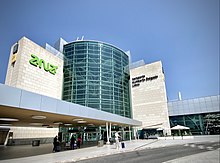
Humberto Delgado Airportis located within the city limits.
It is the headquarters and hub forTAP Portugalas well as a hub forEasyJet,Azores Airlines,Ryanair,EuroAtlantic Airways,White Airways,andHi Fly.Having served 33.65 million passengers in 2023, it is by far the busiest airport in Portugal, the third busiest in the Iberian Peninsula and the 12thbusiest in Europe.[148][149]
A second airport has been proposed, but the project has been put on hold because of the Portuguese and European economic crisis, and also because of the long discussion on whether a new airport is needed. In 2023 there were still 9 possible sites who are thought to be able to host the future New Lisbon airport.[150][151]
Cascais Municipal Aerodrome,20 km West of the city centre and hub forSevenair,inCascais,offers commercial domestic flights toBragança,Portimão,ViseuandVila Real.This location is where many of the country's aviation schools are concentrated.
Cycling[edit]
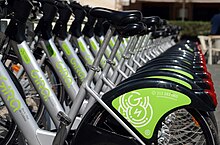
Following the Covid-19 pandemic, Lisbon has seen a significant increase in cycling and plans to expand the current Girabike hire systemfrom 1,600 bikes to 2,600 by the end of 2023.[152]Many of these bicycles areelectricto deal with Lisbon's hills.[153]The city also plans to expand the number of bike recharging stations, now standing at 146. Gira service is integrated in the public transportation system, as youth up to 23 years old and seniors over 65 years old can use the service for free, while for other residents bikes are included in the Navegante card.[154][155]
In 2023 there were over 200 kilometers of bike lanes within the city's administrative area and the city plans to expand its network of cycle paths in the next years.[156][157][158][159]
Public transportation statistics[edit]
The average amount of time people spend commuting with public transit in Lisbon, for example to and from work, on a weekday is 59 min. 11.5% of public transit riders, ride for more than 2 hours every day. The average amount of time people wait at a stop or station for public transit is 14 min, while 23.1% of riders wait for over 20 minutes on average every day. The average distance people usually ride in a single trip with public transit is 6 km, while 10% travel for over 12 km in a single direction.[160]
Car[edit]
Lisbon is connected to its suburbs and throughout Portugal by an extensive motorway network. There are three circular motorways around the city; the 2ª Circular, the IC17 (CRIL), and the A9 (CREL).
Education[edit]
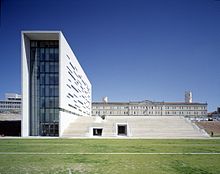
International schools[edit]
InGreater Lisbonarea, particularly in thePortuguese Riviera,an area popular withexpatsand foreign nationals, there are numerousinternational schools,including theCarlucci American International School of Lisbon(only American school in Portugal),Saint Julian's School(British),Saint Dominic's International School(British),Deutsche Schule Lissabon(German),Instituto Español Giner de los Ríos(Spanish),Oerias Internacional School (IB), andLycée Français Charles Lepierre(French).
Higher education[edit]

In the city, there are threepublic universitiesand auniversity institute.TheUniversity of Lisbon,which is the largest university in Portugal, was created in 2013 with the union of theTechnical University of Lisbonand the Classical University of Lisbon (which was known as the University of Lisbon). TheNew University of Lisbon,founded in 1973, is another public university in Lisbon and is known internationally by itsNova School of Business and Economics(Nova SBE), its economics and management faculty. The third public university isUniversidade Aberta.Additionally, there'sISCTE - Lisbon University Institute(founded in 1972), a university institute that provides degrees in all academic disciplines.
Major private institutions of higher education include thePortuguese Catholic University,focused on law and management, as well as the Lusíada University, theUniversidade Lusófona,and theUniversidade Autónoma de Lisboa,among others.
The total number of enrolled students in higher education in Lisbon was, for the 2007–2008 school year, of 125,867 students, of whom 81,507 in the Lisbon's public institutions.[161]
Libraries[edit]
Lisbon is home toBiblioteca Nacional de Portugal,the Portuguese national library, which has over 3 million books and manuscripts. The library has some rare books and manuscripts, such as an original Gutenberg Bible and original books byErasmus,Christophe PlatinandAldus Manutius.Torre do Tombo,thenational archive,is one of the most important archives in the world, with over 600 years and one of the oldest active Portuguese institutions. There are, among several others, theArquivo Histórico Ultramarinoand the Arquivo Histórico Militar.
Sports[edit]
Lisbon has a long tradition in sports. It hosted several matches, including thefinal,of theUEFA Euro 2004championship. The city also played host to the final of the2001 IAAF World Indoor Championshipsand theEuropean Fencing Championshipsin 1983 and 1992, as well as the2003 World Men's Handball Championship,and the2008 European Judo Championships.From 2006 to 2008, Lisbon was the starting point for theDakar Rally.The city hosted the2014and2020UEFA Champions Leaguefinals. In 2008 and 2016, the city hosted theEuropean Triathlon Championships.Lisbon has a leg at theVolvo Ocean Race.It is one of the potential host cities for the2030 FIFA World Cup.
Football[edit]
The city hosts threeassociation footballclubs in Portugal's highest league, thePrimeira Liga.Sport Lisboa e Benfica,commonly known as simplyBenfica,has won 38 league titles in addition to twoEuropean Cups.Lisbon's second-most successful club isSporting Clube de Portugal(commonly known asSportingand often referred to asSporting Lisbonabroad to prevent confusion with other teams with the same name), winner of 20 league titles and theUEFA Cup Winners' Cup.A third club,C.F. Os Belenenses(commonlyBelenensesorBelenenses Lisbon), based in theBelémquarter, has solely won one league title. Other major clubs in Lisbon includeAtlético,Casa Pia,andOriental.
Lisbon has twoUEFA category four stadiums;Benfica'sEstádio da Luz(Stadium of Light), with a capacity of over 65,000 and Sporting'sEstádio José Alvalade,with a capacity of over 50,000. The Estádio da Luz held both the2014and2020 UEFA Champions League Final.There is also Belenenses'Estádio do Restelo,with a capacity of over 19,000. TheEstádio Nacional,in nearbyOeiras,has a capacity of 37,000 and was used exclusively forPortugueseinternational football matches and cup finals until the construction of larger stadia in the city. It held the1967 European Cup Final.
Other sports[edit]
Other sports, such asbasketball,futsal,handball,roller hockey,rugby unionandvolleyballare also popular; the latter's national stadium is in Lisbon. There are many other sports facilities in Lisbon, ranging from athletics, sailing, golfing tomountain-biking.Lisboa and Troia golf course are two of many stunninggolf courseslocated in Lisbon. Every March the city hosts theLisbon Half Marathon,while in September thePortugal Half Marathon.
International relations[edit]
Twin towns – sister cities[edit]
 Bissau,Guinea-Bissau (1985)
Bissau,Guinea-Bissau (1985) Budapest,Hungary (1992)
Budapest,Hungary (1992) Cacheu,Guinea-Bissau (1988)
Cacheu,Guinea-Bissau (1988) Fortaleza,Brazil (2016)[163]
Fortaleza,Brazil (2016)[163] Guimarães,Portugal (1993)
Guimarães,Portugal (1993) Luanda,Angola (1988)
Luanda,Angola (1988)
 Macau,China (1982)
Macau,China (1982) Madrid,Spain (1979)
Madrid,Spain (1979) Malacca City,Malaysia (1984)
Malacca City,Malaysia (1984) Maputo,Mozambique (1982)
Maputo,Mozambique (1982) Praia,Cape Verde (1983)
Praia,Cape Verde (1983) Rabat,Morocco (1988)
Rabat,Morocco (1988) Panaji,India
Panaji,India Rio de Janeiro,Brazil (1980)
Rio de Janeiro,Brazil (1980) Salvador,Brazil (1995)
Salvador,Brazil (1995) São Tomé,São Tomé and Príncipe (1985)
São Tomé,São Tomé and Príncipe (1985)
Cooperation agreements[edit]
Lisbon has additional cooperation agreements with:[162]
 Algiers,Algeria (1988)
Algiers,Algeria (1988) Asunción,Paraguay (2014)
Asunción,Paraguay (2014) Bangkok,Thailand (2016)[164]
Bangkok,Thailand (2016)[164] Beijing,China (2007)
Beijing,China (2007) Bethlehem,Palestine (1995)
Bethlehem,Palestine (1995) Buenos Aires,Argentina (1992)
Buenos Aires,Argentina (1992) Curitiba,Brazil (2005)
Curitiba,Brazil (2005) Haimen,China (2011)
Haimen,China (2011) Kyiv,Ukraine (2000)
Kyiv,Ukraine (2000) Miami,United States (1987)
Miami,United States (1987) Montevideo,Uruguay (1993)
Montevideo,Uruguay (1993) Panaji,India (1989)
Panaji,India (1989) Paris,France (1998)
Paris,France (1998) Qingdao,China (2010)
Qingdao,China (2010) Santa Catarina,Cape Verde (1997)
Santa Catarina,Cape Verde (1997) Sofia,Bulgaria (2001)
Sofia,Bulgaria (2001) Toronto,Canada (1987)
Toronto,Canada (1987) Tunis,Tunisia (1993)
Tunis,Tunisia (1993) Zagreb,Croatia (1977)
Zagreb,Croatia (1977)
Membership in organizations[edit]
From 12 October 1982, Lisbon is part of theUnion of Ibero-American Capital Cities.[162][165]
From 28 June 1985, Lisbon is part of the Union of Capital Cities of Portuguese Language, along with 22 other cities from Angola, Brazil, Cape Verde, China, East Timor, Guinea-Bissau, Mozambique, Portugal, and São Tomé and Príncipe.[162][166]
See also[edit]
References[edit]
- ^"Statistics Portugal - Web Portal".ine.pt.
- ^"Statistics Portugal - Web Portal".ine.pt.
- ^Wells, John C. (21 July 2010)."Portuguese".Archivedfrom the original on 8 April 2012.Retrieved17 June2012.
- ^ab"Áreas das freguesias, concelhos, distritos e país".Archived fromthe originalon 5 November 2018.Retrieved5 November2018.
- ^"INE.pt".
- ^Rudlin, David; Thompson, Rob; Jarvis, Sarah (2016).Urbanism.Taylor & Francis. p. 45.ISBN978-1-317-21390-1.Archivedfrom the original on 14 January 2023.Retrieved14 January2023.
- ^Central Intelligence Agency (2021).The CIA World Factbook 2021-2022.Simon and Schuster. p. 3319.ISBN978-1-5107-6382-1.Archivedfrom the original on 14 January 2023.Retrieved14 January2023.
- ^abH. V. Livermore (1973).Portugal: A Short History.Edinburgh University Press. p. 4.ISBN978-0-85224-207-0.Archivedfrom the original on 7 February 2023.Retrieved5 September2019.
- ^Ferreira, Marta Leite."Lisboa não é a capital de Portugal e outros 9 factos que não aprendeu nas aulas de História".Observador(in European Portuguese).Retrieved23 August2023.
- ^"Corpo Diplomático em Portugal".Portal Diplomático(in European Portuguese).Retrieved23 August2023.
- ^ab"Statistics Portugal - Web Portal".ine.pt.Retrieved23 August2023.
- ^abDemographia: World Urban AreasArchived17 May 2017 at theWayback Machine- demographia, 06.2021
- ^"The World According to GaWC 2010".Globalization and World Cities Research Network.Archivedfrom the original on 10 October 2013.Retrieved23 November2012.
- ^"GaWC - The World According to GaWC 2020".lboro.ac.uk.Retrieved23 August2023.
- ^"The World According to GaWC 2010".Globalization and World Cities Study Group and Network,Loughborough University.Archivedfrom the original on 10 October 2013.Retrieved3 March2009.
- ^"Inventory of World Cities".Globalization and World Cities (GaWC) Study Group and Network. Archived fromthe originalon 14 October 2013.Retrieved1 December2007.
- ^TUCKER "," ANDREA MURPHY "," HANK."The Global 2000 2023".Forbes.Retrieved23 August2023.
{{cite web}}:CS1 maint: multiple names: authors list (link) - ^"Statistics Portugal - Web Portal".ine.pt.Retrieved13 February2024.
- ^"1. Gross domestic product (GDP): GDP per capita, USD, current prices and PPPs".stats.oecd.org.Retrieved13 February2024.
- ^"Purchasing Power Parities for GDP and related indicators".stats.oecd.org.Retrieved13 February2024.
- ^"Global city GDP rankings 2008–2025".Pricewaterhouse Coopers. Archived fromthe originalon 13 May 2011.Retrieved16 December2009.
- ^"Ranking: The richest cities in the world"Archived23 March 2019 at theWayback Machine– City Mayors
- ^"Worlds Wealthiest Cities 2023".Henley & Partners.Retrieved23 August2023.
- ^"Lisboa é 9ª cidade que mais recebe congressos internacionais"– Agência LUSA
- ^Pliny the Elder (21 May 2015). "35, note 22". In John Bostock; H.T. Riley (eds.).Pliny the Elder: The Natural History Book IV.Bloomsbury.ISBN978-1-4725-2101-9.Archivedfrom the original on 28 April 2017.Retrieved4 September2019.
Now Lisbon. Both Strabo, Solinus, and Martianus Capella make mention of a story that Ulysses came to Spain and founded this city.
- ^William Harris Stahl; E. L. Burge; Richard Johnson (June 1992).Martianus Capella and the Seven Liberal Arts: The Marriage of Philology and Mercury.Vol. II. Columbia University Press. p. 233.ISBN978-0-231-09636-2.Archivedfrom the original on 7 February 2023.Retrieved4 September2019.
- ^Adrien Delmas; Nigel Penn (20 January 2012).Written Culture in a Colonial Context: Africa and the Americas 1500–1900.BRILL. p. 348.ISBN978-90-04-22524-4.Archivedfrom the original on 5 May 2016.Retrieved29 October2015.
- ^Vincent Barletta (15 May 2010).Death in Babylon: Alexander the Great and Iberian Empire in the Muslim Orient.University of Chicago Press. p. 39.ISBN978-0-226-03739-4.Archivedfrom the original on 28 November 2016.Retrieved15 May2016.
- ^Justino Mendes de Almeida (1992).De Olisipo a Lisboa: estudos olisiponenses.Edições Cosmos. p. 19.ISBN978-972-9170-75-1.Archivedfrom the original on 10 June 2016.Retrieved29 October2015.
...que o nomeLisboaderivaria de um acusativo grego da 3° declinação,Olisipona.",p. 19, (...the name Lisbon derives from the third declension of the Greek accusative singular,Olisipona.)
- ^Smith, William (1854),Dictionary of Greek and Roman Geography, illustrated by numerous engravings on wood,London, England: Walton and Maberly
- ^Various, compiled (1780).An Universal History, From the Earliest Accounts to the Present Time.p. 345.Archivedfrom the original on 28 November 2016.Retrieved15 May2016.
- ^Ferreira, Emília; Cabello, Jorge (1998).Lisbon.Casa Editrice Bonechi. p. 3.ISBN978-88-8029-394-1.Archivedfrom the original on 11 March 2022.Retrieved11 March2022.
- ^abJack, Malcolm (2019).Lisbon, City of the Sea: A History.Bloomsbury Publishing. p. 138.ISBN978-1-83860-172-0.Archivedfrom the original on 11 March 2022.Retrieved11 March2022.
- ^abPeter Whitfield (2005).Cities of the World: A History in Maps.University of California Press. p. 99.ISBN978-0-520-24725-3.Archivedfrom the original on 28 November 2016.Retrieved15 May2016.
- ^Burstein, Eitan (Winter 2019). Elbl, Martin Malcolm (ed.)."The Meaning of the Toponym 'Lisbon' Explained through Biblical Etymology"(PDF).Portuguese Studies Review.27(2): 3.ISSN1057-1515.Archived(PDF)from the original on 3 April 2022.Retrieved11 March2022.
We surmise that the Phoenician toponym, the origin of Olisipo, should be neither Alits Ub(b)o, a form proposed by some scholars (e.g. Samuel Bochart, 1599−1667) notwithstanding the fact that it is never attested in ancient classical literature, nor the commonly accepted Alis Ubbo (see for instance the title of a documentary film produced in 2018, in a cynical sense), but a different form altogether. We shall use Hebrew to substantiate our argument.
- ^"Lx., abreviatura de Lisboa - Ciberdúvidas da Língua Portuguesa".ciberduvidas.iscte-iul.pt.Archivedfrom the original on 4 April 2019.Retrieved7 April2020.
- ^Rodrigo Banha da Silva (September 2013)."A ocupação da idade do bronze final da Praça da Figueira (Lisboa): novos e velhos dados sobre os antecedentes da cidade de Lisboa"(PDF).Cira Arqueologia.Cira Arqueologia II (in Portuguese) (2, Tejo, palco de interação entre Indígenas e Fenícios). Museu da Rede Portuguesa de Museus. Archived fromthe original(PDF)on 21 June 2014.Retrieved21 June2014.
- ^Carlos Gómez Bellard (2003).Ecohistoria del paisaje agrario: La agricultura fenicio-púnica en el Mediterráneo.Universitat de València. p. 213.ISBN978-84-370-5508-4.Archivedfrom the original on 28 November 2016.Retrieved12 October2016.
- ^Ana Margarida Arruda(2002).Los fenicios en Portugal: fenicios y mundo indígena en el centro y sur de Portugal (siglos VIII-VI a.C.).Carrera Edició. pp. 113–115.ISBN978-84-88236-11-1.Archivedfrom the original on 28 November 2016.Retrieved12 October2016.
- ^John Laidlar (1997).Lisbon.Clio Press. p. 63.ISBN978-1-85109-268-0.
- ^Nathan Laughlin Pilkington (2013).An Archaeological History of Carthaginian Imperialism.Academic Commons, Columbia.edu(Thesis). Columbia University. p. 170.doi:10.7916/D80G3SCF.Archivedfrom the original on 3 September 2014.Retrieved19 August2014.
- ^David Wright; Patrick Swift (1 January 1971).Lisbon: a portrait and a guide.Barrie and Jenkins. p. 150.ISBN978-0-214-65309-4.Archivedfrom the original on 7 February 2023.Retrieved12 October2016.
- ^Wachsmann, Shelley; Dunn, Richard K.; Hale, John R.; Hohlfelder, Robert L.; Conyers, Lawrence B.; Ernenwein, Eileen G.; Sheets, Payson; Blot, Maria Luisa Pienheiro; Castro, Filipe; Davis, Dan (September 2009)."The Palaeo-Environmental Contexts of Three Possible Phoenician Anchorages in Portugal"(PDF).International Journal of Nautical Archaeology.38(2). Blackwell Publishing Ltd.: 221–253.Bibcode:2009IJNAr..38..221W.doi:10.1111/j.1095-9270.2009.00224.x.S2CID130964094.Archived fromthe original(PDF)on 13 October 2016.
- ^Pedro Telhado Pereira; Maria Eugénia Mata (6 December 2012).Urban Dominance and Labour Market Differentiation of a European Capital City: Lisbon 1890–1990.Springer Science & Business Media. p. 123.ISBN978-94-011-5382-9.Archivedfrom the original on 28 November 2016.Retrieved12 October2016.
- ^"Cerca Moura de Lisboa afinal é romana",Francisco Nieves,publico.pt, 11 October 2001,archivedfrom the original on 5 August 2020,retrieved15 April2018
- ^Pires, Helio. "Sigurđr's Attack on Lisbon: Where Exactly?" InViking and Medieval Scandinavia8 (2012) – Turnhout, Belgium: Brepols Publishers, c=2012, pp. 199–205.
- ^Jessica V. Roitman (14 February 2011).The Same But Different?: Inter-cultural Trade and the Sephardim, 1595–1640.BRILL. p. 33.ISBN978-90-04-20276-4.
- ^Soyer, F. (2007)."The Massacre of the New Christians of Lisbon in 1506: A New Eyewitness Account"(PDF).Cadernos de Estudos Sefarditas.7:221.Archived(PDF)from the original on 7 April 2022.Retrieved29 May2022.
- ^Paulo Mendes Pinto; Susana Bastos Mateus (2 September 2014).The Massacre of the Jews: Lisbon April 19, 1506.Alêtheia Editores. p. 44.ISBN978-989-622-665-7.
- ^Jeffrey S. Ruth, ed. (1996) [1554], "Urbis Olisiponis descriptio",Lisbon in the Renaissance,New York, New York
{{citation}}:CS1 maint: location missing publisher (link) - ^EncyclopædiaBritannica."John IV (king of Portugal)".Archivedfrom the original on 13 March 2012.Retrieved10 March2012.
king of Portugal from 1640 as a result of the national revolution or restoration, which ended 60 years of Spanish rule.
- ^Geoffrey ParkerThe army of Flanders and the Spanish road,London, 1972ISBN0-521-08462-8,p. 35
- ^Pereira, A.S. (March 2006)."The Opportunity of a Disaster: The Economic Impact of the Lisbon 1755 Earthquake"(PDF).Centre for Historical Economics and Related Research at York, York University.Archived(PDF)from the original on 5 June 2011.Retrieved21 November2010.
- ^"The Economic Impact of the Lisbon 1755 Earthquake – p. 8, estimates a population of 200,000"(PDF).March 2006.Archived(PDF)from the original on 5 June 2011.Retrieved21 November2010.
- ^"Historical Depictions of the 1755 Lisbon Earthquake, citing an unreferenced estimate of 275,000".Nisee.berkeley.edu. 12 November 1998. Archived fromthe originalon 11 March 2011.Retrieved21 November2010.
- ^"Historical Depictions of the 1755 Lisbon Earthquake".Nisee.berkeley.edu. 12 November 1998. Archived fromthe originalon 11 March 2011.Retrieved21 November2010.
- ^"PortugalArchived21 January 2017 at theWayback Machine".The Virtual Jewish History Tour.
- ^"Welcome to the official global voting platform of".New7Wonders.Archivedfrom the original on 20 December 2009.Retrieved8 July2009.
- ^"NATO,NATO Summit Meetings,4 December 2006 ".Archived fromthe originalon 14 September 2011.Retrieved7 April2020.
- ^"Meeting Spotlight | The meeting planner destination resource".meetingspotlight.Archivedfrom the original on 24 February 2020.Retrieved7 April2020.
- ^"Photos: Ismaili Imamat establishes headquarters in Portugal".Archivedfrom the original on 26 October 2020.Retrieved22 October2020.
- ^Darcy, Marie-Line (12 July 2018)."Lisbon as the 'Holy See' for Ismaili Shia Muslims".Archivedfrom the original on 26 October 2020.Retrieved22 October2020.
- ^"What is it - WYD Lisbon 2023".JMJ 2023.19 September 2022. Archived fromthe originalon 6 June 2023.Retrieved2 October2023.
- ^Deborah Castellano Lubov (2 August 2023)."Pope Francis arrives in Portugal for World Youth Day - Vatican News".vaticannews.va.Archived fromthe originalon 17 August 2023.Retrieved2 October2023.
- ^White, Christopher (6 August 2023)."Pope Francis to 1.5 million youth in Portugal: Be 'beacons of hope in dark times'".National Catholic Reporter.Retrieved2 October2023.
- ^IGP, ed. (2011),Carta Administrativa Oficial de Portugal(in Portuguese), Lisbon, Portugal: Instituto Geográfico Português
- ^"World Map of Köppen−Geiger Climate Classification".Archived fromthe originalon 6 September 2010.
- ^abLisbon average sea temperatureArchived7 March 2018 at theWayback Machine– seatemperature.org.
- ^Sintra Base areaipma.pt
- ^Setubalipma.pt
- ^"Sábado foi o dia mais quente de sempre em Lisboa e noutros 24 locais"[G. Coutinho and Tapada weather stations measure the Lisbon highest temperature record]. 5 August 2018.Archivedfrom the original on 20 May 2019.Retrieved24 February2019.
- ^"Climatological Normals of Lisbon".Archived fromthe originalon 29 January 2019.Retrieved31 August2017.
- ^ab"Monthly Averages for Lisbon, Portugal (1981–2010)"(PDF).Instituto Português do Mar e da Atmosfera.Archivedfrom the original on 26 November 2012.Retrieved10 August2012.
- ^"Climatological Information for Lisbon, Portugal" (1961–1990)Archived29 January 2019 at theWayback Machine– Hong Kong Observatory
- ^Diário da República."Law nr. 56/2012, pages 6454–6460"(pdf)(in Portuguese).Archivedfrom the original on 29 November 2014.Retrieved20 November2014.
- ^Joaquim Carvalho (2007).Religion and Power in Europe: Conflict and Convergence.Edizioni Plus. p. 38.ISBN978-88-8492-464-3.Archivedfrom the original on 9 May 2016.Retrieved29 October2015.
- ^Michael Colvin (2008).The Reconstruction of Lisbon: Severa's Legacy and the Fado's Rewriting of Urban History.Associated University Presse. p. 98.ISBN978-0-8387-5708-6.Archivedfrom the original on 8 May 2016.Retrieved29 October2015.
- ^François Soyer (15 October 2007).The Persecution of the Jews and Muslims of Portugal: King Manuel I and the End of Religious Tolerance (1496–7).BRILL. p. 41.ISBN978-90-04-16262-4.Archivedfrom the original on 3 June 2016.Retrieved29 October2015.
- ^Patrick O'Flanagan (1 January 2008).Port Cities of Atlantic Iberia, C. 1500–1900.Ashgate Publishing, Ltd. p. 147.ISBN978-0-7546-6109-2.Archivedfrom the original on 11 May 2016.Retrieved29 October2015.
- ^Revista, Visão (June 2018)."Tudo o que há para ver e fazer de Marvila ao Beato".Visao.Archivedfrom the original on 14 January 2020.Retrieved14 January2020.
- ^Revista, TimeOut (December 2019)."Roteiro perfeito em Marvila".TimeOut.Archivedfrom the original on 14 January 2020.Retrieved14 January2020.
- ^de Negócios, Jornal (May 2017)."Lisboa: ocírculo alternativo das galerias de arte".Jornal de Negócios.Archivedfrom the original on 14 January 2020.Retrieved14 January2020.
- ^"Official web-site".Lisbon Gay and Lesbian Film Festival.Archivedfrom the original on 26 October 2006.Retrieved6 November2006.
- ^"doclisboa 2009".Doclisboa.org.Archivedfrom the original on 7 July 2009.Retrieved8 July2009.
- ^"Feira do Livro de Lisboa".Feiradolivrodelisboa.pt.Archivedfrom the original on 1 March 2010.Retrieved30 April2010.
- ^"Peixe em Lisboa".Peixemlisboa.Archivedfrom the original on 13 February 2009.Retrieved8 July2009.
- ^"Trienal de Arquitectura de Lisboa".trienaldelisboa.Archivedfrom the original on 5 June 2009.Retrieved8 July2009.
- ^"ModaLisboa – LisboaFashionWeek – Semana oficial da moda portuguesa".Modalisboa.pt.Archivedfrom the original on 2 August 2009.Retrieved8 July2009.
- ^"Experimentadesign".Experimentadesign.pt.Archivedfrom the original on 10 July 2009.Retrieved8 July2009.
- ^"Luzboa 2008".Luzboa.Archivedfrom the original on 1 October 2009.Retrieved8 July2009.
- ^McKeown, Jonah (1 August 2023)."World Youth Day 2023: Lisbon patriarch greets attendees at opening Mass".Catholic News Agency.
- ^Instituto Nacional de Estatística (Recenseamentos Gerais da População) -https:// ine.pt/xportal/xmain?xpid=INE&xpgid=ine_publicacoesArchived10 July 2017 at theWayback Machine
- ^Paul Bairoch (1991).Cities and Economic Development: From the Dawn of History to the Present.University of Chicago Press. p. 180.ISBN978-0-226-03466-9.Archivedfrom the original on 28 July 2014.Retrieved13 December2015.
- ^Luis Frois SJ (2014).The First European Description of Japan, 1585: A Critical English-Language Edition of Striking Contrasts in the Customs of Europe and Japan by Luis Frois, S.J.Routledge. p. 194.ISBN978-1-317-91781-6.Archivedfrom the original on 18 July 2014.Retrieved13 December2015.
- ^Richard W. Mansbach;Kirsten L. Taylor (2013).Introduction to Global Politics.Routledge. p. 40.ISBN978-1-136-51738-9.Archivedfrom the original on 27 July 2014.Retrieved13 December2015.
- ^Metro eXplorerArchived10 April 2015 at theWayback Machine– OECD
- ^World Urbanization ProspectsArchived25 May 2017 at theWayback Machine– Department of Economic and Social Affairs, United Nations, 2007
- ^"Population by sex and age groups on 1 January"Archived22 August 2016 at theWayback Machine–Eurostat,2012
- ^2014 Global Metro MonitorArchived21 March 2015 at theWayback Machine– Brookings Institution, 2015
- ^"Census - Final results: Portugal - 2021".Statistics Portugal.Archivedfrom the original on 23 November 2022.Retrieved23 November2022.
- ^"Grande Lisboa. Menos católica e religiosa, mas crente e tolerante".Jornal Expresso(in European Portuguese).Retrieved23 August2023.
- ^"Portal do INE".ine.pt.Retrieved23 August2023.
- ^"How much does Catholic religion matter to young people? The case of Portugal"(PDF).
- ^Raposo, Frederico (7 August 2021)."Menos lares, mais alojamento local: como o centro histórico de Lisboa perdeu 8 mil habitantes em dez anos".Mensagem de Lisboa(in European Portuguese).Retrieved23 August2023.
- ^"Lisboa perde 1,4 % de população. Demógrafa aponta para falta de oferta e preços das casas".SIC Notícias(in Portuguese). 28 July 2021.Retrieved23 August2023.
- ^"Digital nomads in Portugal: Can they be blamed for a housing crisis?".euronews.12 May 2023.Retrieved23 August2023.
- ^"Portugal housing crisis: 'I'll have to move back in with mum'".BBC News.28 May 2023.Retrieved23 August2023.
- ^"Vivem 118.947 estrangeiros em Lisboa. Eis as principais nacionalidades".Notícias ao Minuto(in Portuguese). 28 February 2023.Retrieved23 August2023.
- ^"Statistics Portugal - Web Portal".ine.pt.Retrieved13 February2024.
- ^"GDP per inhabitant in 2004"(PDF).Eurostat. Archived fromthe original(PDF)on 26 March 2009.Retrieved17 November2012.
- ^"GDP per inhabitant in 2005"(PDF).Eurostat. Archived fromthe original(PDF)on 16 February 2008.Retrieved17 November2012.
- ^"GDP per inhabitant in 2006"(PDF).Eurostat. Archived fromthe original(PDF)on 25 March 2009.Retrieved17 November2012.
- ^"GDP per inhabitant in 2007"(PDF).Eurostat. Archived fromthe original(PDF)on 9 November 2014.Retrieved17 November2012.
- ^"Global Metro Monitor GDP 2014".Brookings Institution. 22 January 2015.Archivedfrom the original on 21 March 2015.Retrieved16 February2015.
- ^"Eurogate Lisbon".Archivedfrom the original on 10 November 2017.Retrieved9 November2017.
- ^"Euronext | LinkedIn".linkedin.Retrieved4 November2023.
- ^"Pequeno Resumo Histórico de Lisboa"Archived20 April 2010 at theWayback Machine– Câmara Municipal de Lisboa
- ^"The Monocle Quality of Life Survey 2019".Monocle.2019.Archivedfrom the original on 1 March 2020.Retrieved25 September2020.
- ^"Top 100 City Destinations: 2019 Edition | Euromonitor".Euromonitor International.Retrieved24 August2023.
- ^"Lisbon, Portugal - Image of the Week - Earth Watching".earth.esa.int.Retrieved24 August2023.
- ^"Top 100 City Destinations: 2019 edition"(PDF).
- ^"What are the most and least 'over-touristed' capital cities in Europe?".euronews.14 May 2023.Retrieved24 August2023.
- ^"Lisbon is the sixth most popular city for business tourism".theportugalnews.Retrieved24 August2023.
- ^"Portugal named best tourism destination in Europe, 5th time in last six years".Fall River Herald News.Retrieved24 August2023.
- ^"TravelBI by Turismo de Portugal - Turismo em Números - 2022".travelbi.turismodeportugal.pt.Retrieved18 November2023.
- ^Caetano, Edgar."Cada turista em Lisboa vai gastar este ano, em média, 911 euros. Turismo vai dar 17,4 mil milhões à economia (sem contar com a JMJ)".Observador(in European Portuguese).Retrieved24 August2023.
- ^Electrical World.McGraw-Hill. 1900. p. 566.
- ^Archived copyArchived3 January 2007 at theWayback MachineInformation from Carris, Lisbon transportation company.
- ^"Luso Pages - Lisbon (Portugal) Trams".Archived fromthe originalon 15 May 2011.Retrieved10 March2011.Details of Lisbon's trams, from Luso Pages
- ^Pincha, João Pedro (3 April 2019)."Rede de eléctricos da Carris vai ligar o Jamor a Sacavém".PÚBLICO(in Portuguese).Retrieved24 August2023.
- ^Raposo, Frederico (2 November 2021)."Os elétricos não são só para turista ver. Podem ser o futuro da mobilidade em Lisboa".Mensagem de Lisboa(in European Portuguese).Retrieved24 August2023.
- ^Raposo, Frederico (9 September 2022)."Elétricos vão duplicar e Lisboa estuda" novas linhas de metro ligeiro ". Amadora - Sta. Apolónia pode ser a primeira".Mensagem de Lisboa(in European Portuguese).Retrieved24 August2023.
- ^"Novos elétricos da Carris chegam a Algés e há planos de expansão até à Cruz Quebrada".New in Oeiras(in European Portuguese). 8 May 2023.Retrieved24 August2023.
- ^"Elétricos Articulados".carris.pt(in Portuguese).Retrieved24 August2023.
- ^"Elétricos Históricos".carris.pt(in Portuguese).Retrieved24 August2023.
- ^"Elétricos Clássicos".carris.pt(in Portuguese).Retrieved24 August2023.
- ^ab"Carris vai comprar 117 autocarros 100% elétricos até 2026 e um bus a hidrogénio".Retrieved18 November2023.
- ^"Carris reforça frota com 100 autocarros - e são verdes".dn.pt(in European Portuguese). 19 January 2021.Retrieved24 August2023.
- ^"Km de autocarros"(PDF).
- ^"Autocarros 2017"(PDF).
- ^"Carris Metropolitana".Archivedfrom the original on 17 December 2022.Retrieved17 December2022.
- ^"Barraqueiro Transportes".Archivedfrom the original on 16 April 2009.Retrieved31 May2007.
- ^"Suspension bridge".Encyclopædia Britannica.15 November 2016.Archivedfrom the original on 31 January 2018.Retrieved30 January2018.
- ^"The highest, tallest, longest and oldest bridges in the world".The Telegraph.Archivedfrom the original on 31 January 2018.Retrieved30 January2018.
- ^"Plano Ferroviário prevê terceira travessia sobre o Tejo".dn.pt(in European Portuguese). 17 November 2022.Retrieved24 August2023.
- ^Cipriano, Carlos (28 February 2023)."Zero quer prioridade à Terceira Travessia do Tejo exclusivamente ferroviária".PÚBLICO(in Portuguese).Retrieved24 August2023.
- ^"Transtejo e Soflusa".Transtejo.pt.Archivedfrom the original on 13 July 2009.Retrieved8 July2009.
- ^"Movimento de passageiros nos aeroportos portugueses fechou 2022 ainda 5,6% abaixo dos números pré-pandemia".Expresso(in Portuguese). 13 February 2023.Retrieved23 August2023.
- ^"Lisboa no top 10 dos aeroportos com mais passageiros".TSF Rádio Notícias(in European Portuguese). 29 April 2022.Retrieved23 August2023.
- ^"Avaliação de Impacte Ambiental pode adiar decisão de novo aeroporto mais um ano".Dinheiro Vivo(in European Portuguese). 29 July 2023.Retrieved24 August2023.
- ^ECO (8 July 2023)."Comissão Técnica já definiu os cinco critérios de decisão para o novo aeroporto de Lisboa".ECO(in European Portuguese).Retrieved24 August2023.
- ^Moreira, Cristiana Faria (15 November 2022)."Câmara de Lisboa quer pôr mais 1000 bicicletas Gira na rua em 2023".PÚBLICO(in Portuguese).Retrieved24 August2023.
- ^"Sobre a gira - GIRA - Bicicletas de lisboa".gira-bicicletasdelisboa.pt.Retrieved24 August2023.
- ^"Bicicletas Gira gratuitas para todos os residentes de Lisboa a partir desta segunda-feira".Expresso(in Portuguese). 5 June 2023.Retrieved24 August2023.
- ^"navegante card".Metropolitano de Lisboa, EPE - English.Retrieved24 August2023.
- ^"Esqueça o carro. Lisboa é uma das melhores cidades da Europa para andar de bicicleta".NiT(in European Portuguese).Retrieved24 August2023.
- ^"Lisboa duplica oferta de bicicletas. Utilização subiu 50% num ano".13 February 2021.Archivedfrom the original on 19 April 2021.Retrieved19 April2021.
- ^"mapa rede ciclável".MUNICÍPIO de LISBOA(in European Portuguese).Retrieved24 August2023.
- ^"EMEL pretende gastar 2,5 milhões de euros na requalificação da ciclovia ribeirinha de Lisboa".dn.pt(in European Portuguese). 26 July 2023.Retrieved24 August2023.
- ^"Lisboa Public Transportation Statistics".Global Public Transit Index by Moovit.Archivedfrom the original on 1 September 2017.Retrieved19 June2017.
 Material was copied from this source, which is available under aCreative Commons Attribution 4.0 International License.
Material was copied from this source, which is available under aCreative Commons Attribution 4.0 International License.
- ^"Statistics on enrollment from GPEARI/Ministry of Science, Technology and Higher Education (MCES) (Excel spreadsheet, 2007/08 school year)".Estatistics.gpeari.mctes.pt. Archived fromthe originalon 23 June 2009.Retrieved17 November2012.
- ^abcd"Relações Internacionais".lisboa.pt(in Portuguese). City of Lisbon.Archivedfrom the original on 20 October 2022.Retrieved29 June2022.
- ^"Fortaleza se torna cidade irmã de Lisboa".oestadoce.br(in Portuguese). Oestado. 30 June 2016.Archivedfrom the original on 1 July 2022.Retrieved29 June2022.
- ^The City of Lisbon; Bangkok Metropolitan Administration (19 July 2016)."Friendship And Co-Operation Agreement between The City of Lisbon Portuguese Republic and The Bangkok Metropolitan Administration Kingdom of Thailand"(PDF).Archived(PDF)from the original on 8 October 2016.Retrieved13 January2018.
- ^"Ciudades miembro"(in Portuguese). Unión de Ciudades Capitales Iberoamericanas.Archivedfrom the original on 11 June 2022.Retrieved29 June2022.
- ^"União das Cidades Capitais de Língua Portuguesa"(in Portuguese). União das Cidades Capitais de Língua Portuguesa.Archivedfrom the original on 28 June 2022.Retrieved29 June2022.
Further reading[edit]
External links[edit]
- Visit Portugal– Official page by the Government of Portugal
- Associação de Turismo de Lisboa– Official site of the Lisbon Tourism Association
- OTLIS– Official site of the Lisbon Region Transport Operators Consortium
- Portal das NaçõesOfficial site of Parque das Nações in Lisbon
- Lisbon voted European City of the Year 2012 – Award– Portuguese American Journal
- TVLLisbon TV
- Lisbon
- 2nd-millennium BC establishments
- Capitals in Europe
- Cities in Portugal
- Marinas in Portugal
- Municipalities of Lisbon District
- Phoenician colonies in Portugal
- Populated coastal places in Portugal
- Populated places established in the 2nd millennium BC
- Populated places in Lisbon District
- Port cities and towns in Portugal
- Recipients of the Order of the Tower and Sword
- Roman towns and cities in Portugal












